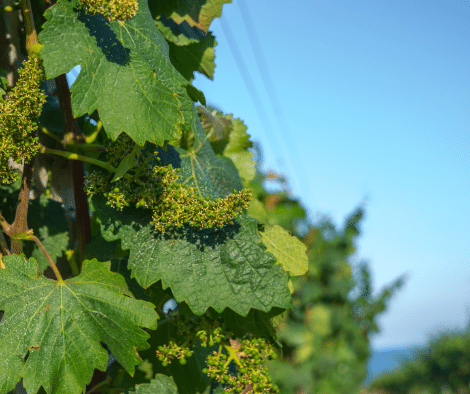Vineyard
After a cool start to the growing season, the vines at Renishaw Hall are starting to catch up and we are now entering full flowering across the vineyard. This is a key time of year for us as heavy rain now can damage these flowers and lead to uneven fruit sets that will affect the quality and quantity of the vintage.
We’re busy tucking in the vines to our trellising wires to ensure that all is as orderly as possible, and that new shoots are growing in the right direction so that tractor operations can continue unimpeded. Like most small vineyards, we are also battling with under vine management – this year that means a lot of strimming. It takes around an hour to strim a row (properly) so in about 60 hours we will be done…!
For the larger producer, there is a wide range of under-vine tools that can be used including mowers and cultivators that can be fitted onto a tractor’s PTO; these are proving to be real game-changers for the industry.

Winery
In the winery we are in good shape, with successful tirage and bottling having taken place. These wines will now be wrapped up with black shrink wrap and stored in the back of the winery to be riddled and disgorged in at least 18 months’ time.
We store everything in as dark conditions as possible to avoid light strike – I have only experienced light strike once, it majorly effected a batch of rosé sparkling wine that I was maturing. It was bottled in clear glass which meant the wine was exposed to the dangers of UV, damaging the top few layers of wine. Lesson learnt.
We have one small batch of white wine that has been fermented and matured in French oak, and – having moved it a couple of weeks ago – I am now waiting for the wine to drop clear before bottling. I am trying to slow my wine making processes down in all aspects of what I am doing, with minimal intervention where possible. With this wine this means no filtration and the use of oak to raise the sweetness and mouthfeel in the wine without using sugars.
Just a note on bottling – we use steam, for the most part, to sterilise what we do, however, I also use peracetic acid (PAA) for bottling, as I know that this will guarantee that there is no unwanted yeast or bacteria in my line if used correctly. PAA is a contact steriliser meaning it is instantaneous and therefore time and money-saving.
Please keep an eye out for more wine content coming to blog throughout Late Summer.
If you would like to discuss your own winemaking process and prepare for the coming harvest, you can email Kieron at kieron.atkinson@murphyandson.co.uk
To view and shop our winemaking store, please click here. We have an extensive range of MLF, Enzymes, Yeast and Inactivated yeasts and more to help you get from soil to cellar.

